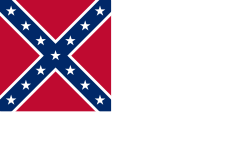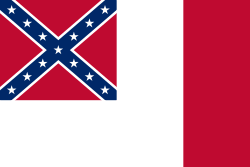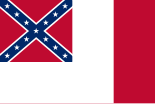Zastava Konfederativnih Američkih Država

 Borbena zastava Konfederacije, izdužena varijanta.
Borbena zastava Konfederacije, izdužena varijanta.Zastava Konfederativnih Američkih Država je zvanična zastava ove bivše zajednice država, koja je korištena tokom Američkog građanskog rata (1861—1865), u nekoliko dizajnerskih verzija. Osim državne zastave, takođe je poznata i Borbena zastava Konfederacije. Nakon završetka rata, brojne verzije ove/ovih zastave su i dalje korištene, kako privatno tako i od zvaničnih institucija, ali uz brojne kontroverze.
Državne zastave Misisipija, Džordžije i Tenesija su bazirane na zastavi Konfederacije. Zastava Severne Karoline je bazirana na zastavi bivše države iz 1861. kada se odvojila od Unije i priključila Konfederaciji. Zastave Alabame i Floride su najverovatnije nastale po uzoru na zastavu Konfederacije, mada je to i dalje nerazjašnjeno.
Opis zastave[uredi | uredi izvor]
Prva državna zastava („Zvezde i pruge“)[uredi | uredi izvor]

 Prva zastava Konfederacije.
Prva zastava Konfederacije.Prva službena zastava Konfederacije, zvana „Zvezde i pruge“, je korištena od 4. marta 1861. do 21. maja 1861. godine.
Prvu državnu zastavu Konfederacije dizajnirao je pruski umetnik Nikola Maršal u Merionu, država Alabama. Zvezde i pruge su prihvaćene kao zastava 4. maja 1861. u Montgomeriju, Alabama. Maršal je takođe dizajnirao i uniformu vojske.[1][2]
Druga državna zastava („Neuprljani barjak“)[uredi | uredi izvor]

 Druga zastava Konfederacije.
Druga zastava Konfederacije.Tokom izbora za drugu državnu zastavu, predloženo je mnogo različitih dizajnerskih rešenja, od kojih su gotovo svi koristili osnovu Borbene zastave, a koja je do 1863. godine postala vrlo poznata i široko prihvaćena. Novi dizajn je odredio Kongres Konfederacije kao belo polje od kojeg dve trećine širine zauzima bela površina, na kojoj se nalazi plavi južnjački krst izdvojen belom linijom od crvene podloge u kojem se nalazi 13 belih zvezda petokraka kao simbol 13 država konfederacije.[3][4]
Treća državna zastava („Krvlju obojeni barjak“)[uredi | uredi izvor]

 Treća zastava Konfederacije.
Treća zastava Konfederacije.Treća državna zastava je usvojena 4. marta 1865. godine, neposredno pre sloma Konfederacije. Ova zastava se ne razlikuje previše od druge državne zastave osim dodatog crvenog polja na desnoj strani. Ovu promenu je u Senatu Konfederacije dizajnirao Artur L. Rodžers koji je naglasio da previše bele boje na zastavi može pogrešno da se protumači kao primirije ili predaja. Dodavanje polja crvene boje imalo je dodatnu nameru da plava boja (koja se smatrala bojom Severa) bude što manje uočljiva na zastavi.[5]
Galerija istorijskih zastava Konfederacije[uredi | uredi izvor]
-
Prva zastava Konfederacije
„7 zvezda i pruge“
(4. mart – 21. maj 1861) -
Prva zastava Konfederacije
„9 zvezda i pruge“
(21. maj – 2. jul 1861) -
Prva zastava Konfederacije
„11 zvezda i pruge“
(2. jul – 28. novembar 1861) -
Prva zastava Konfederacije
„13 zvezda i pruge“
(28. XI 1861–1. III 1863) -
Druga zastava Konfederacije
(1. maj 1863–4. mart 1865) -
Druga zastava Konfederacije
(1. maj 1863–4. mart 1865) -
Treća zastava Konfederacije
(nakon 4. marta 1865) -
Treća zastava Konfederacije
(nakon 4. marta 1865)
Galerija mornaričkih zastava Konfederacije[uredi | uredi izvor]
Galerija zastava nekih država Konfederacije[uredi | uredi izvor]
-
Zastava Misisipija (2001–2020)

Vidi još[uredi | uredi izvor]
- Savezne države SAD
- Zastave saveznih država SAD
- Zastava Sjedinjenih Američkih Država
- Istorija SAD
- Američki građanski rat
Reference[uredi | uredi izvor]
- ^ „Nicola Marschall”. The Encyclopedia of Alabama. 25. 4. 2011. Arhivirano iz originala 06. 06. 2013. g. Pristupljeno 29. 7. 2011. „The flag does resemble that of the Germanic European nation of Austria, which as a Prussian artist, Marschall would have known well.”
- ^ Hume, Erskine (avgust 1940). „The German Artist Who Designed the Confederate Flag and Uniform”. The American-German Review.
- ^ Loewen, James W.; Sebesta, Edward H. (2010). The Confederate and Neo Confederate Reader: The Great Truth about the 'Lost Cause'. Jackson, Mississippi: University Press of Mississippi. str. 13. ISBN 978-1-60473-219-1. OCLC 746462600. Arhivirano iz originala 13. 12. 2013. g. Pristupljeno 5. 12. 2013. „Confederates even showed their preoccupation with race in their flag. Civil War buffs know that 'the Confederate flag' waved today was never the official flag of the Confederate States of America. Rather, it was the flag of the Army of Northern Virginia. During the war, the Confederacy adopted three official flags. The first, sometimes called 'the Stars and Bars,' drew many objections 'on account of its resemblance to that of the abolition despotism against which we are fighting,' in the words of the editor of the Savannah Morning News, quoted herein.”
- ^ Coski, John M. (13. 5. 2013). „The Birth of the 'Stainless Banner'”. The New York Times. The New York Times Company. Arhivirano iz originala 27. 01. 2014. g. Pristupljeno 27. 1. 2014. „A handful of contemporaries linked the new flag design to the “peculiar institution” that was at the heart of the South’s economy, social system and polity: slavery. Bagby characterized the flag motif as the “Southern Cross” – the constellation, not a religious symbol – and hailed it for pointing 'the destiny of the Southern master and his African slave' southward to 'the banks of the Amazon,' a reference to the desire among many Southerners to expand Confederate territory into Latin America. In contrast, the editor of the Savannah, Ga., Morning News focused on the white field on which the Southern Cross was emblazoned. “As a people, we are fighting to maintain the heaven-ordained supremacy of the white man over the inferior or colored races. A White Flag would be thus emblematical of our cause.” He dubbed the new flag “the White Man’s Flag,” a sobriquet that never gained traction.”
- ^ „{title}”. Arhivirano iz originala 30. 1. 2009. g. Pristupljeno 27. 11. 2014.
Literatura[uredi | uredi izvor]
- Loewen, James W.; Sebesta, Edward H. (2010). The Confederate and Neo Confederate Reader: The Great Truth about the 'Lost Cause'. Jackson, Mississippi: University Press of Mississippi. str. 13. ISBN 978-1-60473-219-1. OCLC 746462600. Pristupljeno 5. 12. 2013. „Confederates even showed their preoccupation with race in their flag. Civil War buffs know that 'the Confederate flag' waved today was never the official flag of the Confederate States of America. Rather, it was the flag of the Army of Northern Virginia. During the war, the Confederacy adopted three official flags. The first, sometimes called 'the Stars and Bars,' drew many objections 'on account of its resemblance to that of the abolition despotism against which we are fighting,' in the words of the editor of the Savannah Morning News, quoted herein.”
Spoljašnje veze[uredi | uredi izvor]
]















